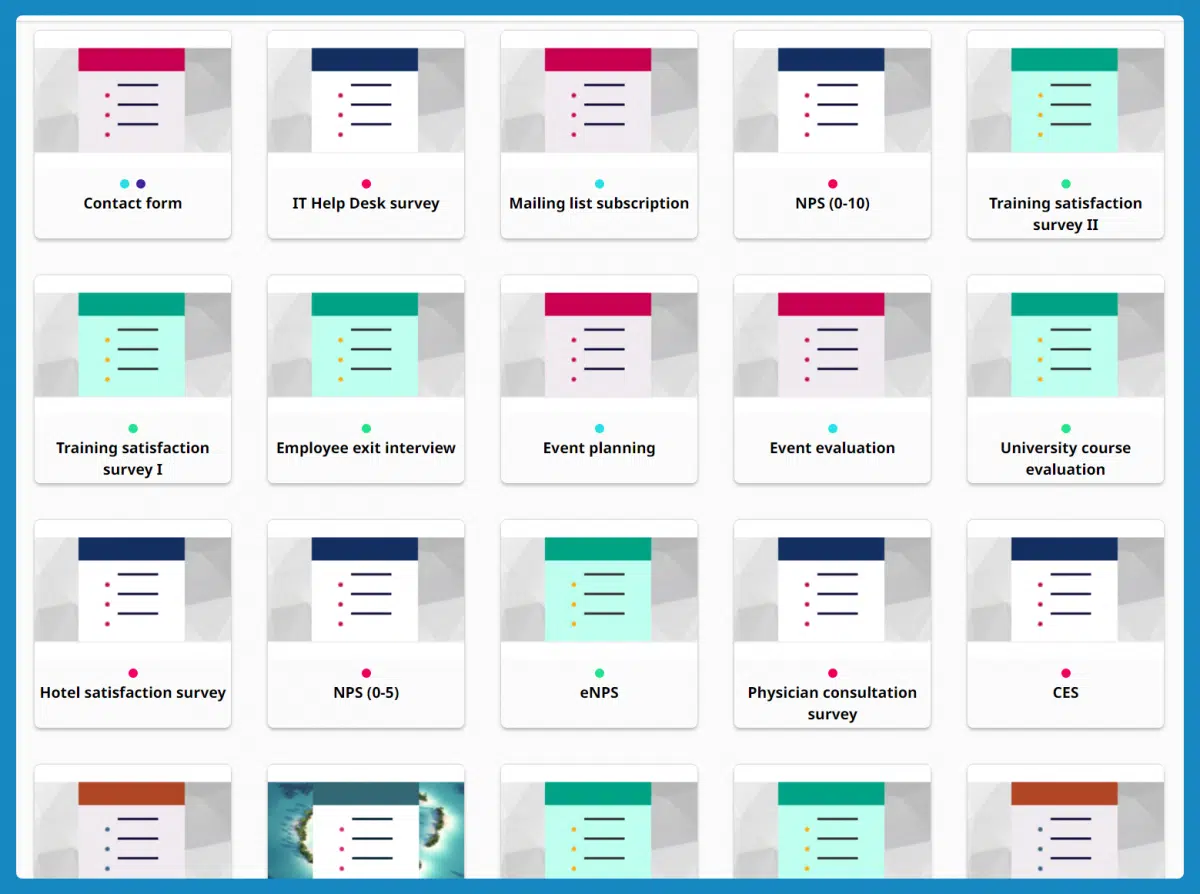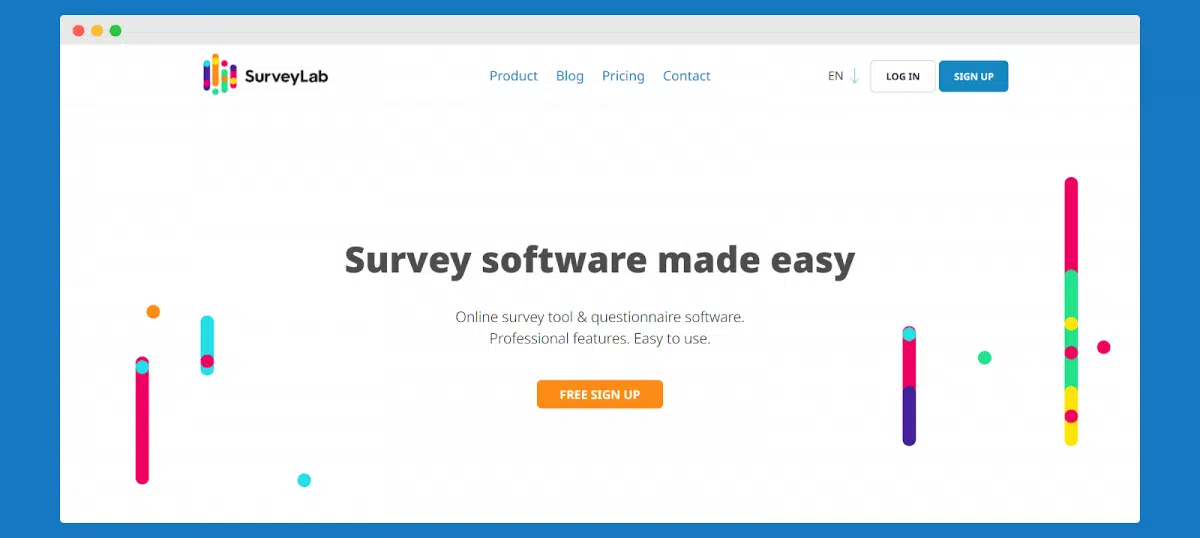Want to know if your survey was a success? Get the answer to this question first ➡️ what is a good response rate for a survey?
The more people share their thoughts, the better the survey is. It’s a must to make the right choices in your business or research.
Today, we’ll show you what a good response rate looks like and how to get it. Scroll down for the numbers.
What is a good response rate for a survey?
A good survey response rate often depends on factors like survey type, target audience, and distribution channel.
Generally, a response rate of 20-25% is considered acceptable for online surveys.
For internal surveys, an acceptable response rate is between 10% and 30%.

Internal surveys are for getting feedback from people inside your company, like employees, about things like job satisfaction and company culture. External surveys are for getting opinions from people outside your company, like customers, about things like how they feel about your products or services.
💡 For more specialized surveys, a higher response rate might be necessary to achieve statistically valid results.
What is an average response rate for surveys?
The average survey response rates typically hover around 20-30%. Again, this also depends based on factors like survey length, survey topic, and the method of distribution.
For example, average online survey response rates are around 40%.
And email surveys often see lower response rates compared to in-person surveys.
How to calculate survey response rate?
Let’s say you sent out 100 surveys to different people. Out of these 100 surveys, you received 60 filled surveys back. To find out the response rate, you would use the formula like this:
Number of responses – this is the number of surveys you got back, which is 60 in our example.
Total number of surveys sent – this is how many surveys you sent out in total, which is 100 in our example.
Now, plug these numbers into the formula:

When you do the calculation, it will look like this:
Response Rate = 0.6×100 = 60%
The response rate for your survey is 60%. So, 60% of the people you sent the survey filled it out and sent it back.
How to turn a good survey response rate into a great survey response rate
Check out if you know all the tips!
#1 Tailor surveys to your target audience
Understand their preferences, needs, and the language they resonate with. For instance, if your target audience is tech-savvy, incorporating technology-related questions or using a more casual tone can be helpful.
Do you work in a tech company? Try to use tech jargon and references (e.g., “software migration for EV charging businesses“), but only if it’s familiar to the audience in the survey.
👉🏻 Here’s what you can do:
❌ How satisfied are you with the ease of using our website? Please rate on a scale from 1 (not at all satisfied) to 5 (extremely satisfied).
➕ On a scale from 1 (strongly disagree) to 5 (strongly agree), how would you rate your satisfaction with our website’s UX/UI design and load times?
The second question uses specific tech terms like “UX/UI design” (User Experience/User Interface design) and “load times,” words that will make more sense to someone familiar with web and app onboarding UI examples and technology like free AI website builders.
This kind of survey, where you ask to share opinions with a range of answer options from “strongly agree” to “strongly disagree,” is called a Likert scale.
#2 Don’t make surveys too long
A key factor in getting a higher survey response rate is optimizing the length of your survey. Surveys that are too long can deter respondents and lead to a lower completion rate.
A general rule is to keep surveys short and to the point.
👉🏻 Here’s what you can do:
If you can, reduce your survey from 20 to 10, maybe 15 questions, and focus on the most important aspects of your research. Then, you may see an increase in completed responses.
People won’t get bored with the survey if it’s straight to the point. Also, many potential respondents may give up at the very beginning when they see, for instance, 50 questions, and most of them are open-ended ones.
Go through them again, review them, and consider if all of them are necessary.
#3 Offer incentives for survey completion
The incentives should be appealing and relevant to your respondents. Nobody will be motivated to complete an online survey if the incentives are not attractive enough.
A common practice is to offer a discount or entry into a prize draw.
👉🏻 Here’s what you can do:
Offer a 10% discount on the next purchase to respondents, which doubled their survey response rate.
Make it clear at the beginning what they will receive after completing the questionnaire. Also, get to know your survey respondents to tailor the incentives to their likings.

Source: Storyset
#4 Use follow-up strategies
Boost response rates with a follow-up email or reminder to encourage respondents who missed or forgot about the survey to participate. Not sure how to reach all your potential respondents? If you’re missing email addresses for some contacts, there are reliable ways to find them. Check out this guide on how to find an email address – it’ll help you connect with people who may not be on your usual list, ensuring your follow-up messages reach as many participants as possible.
People are surrounded by many stimuli, so they might simply forget or stop answering your survey, even though they planned to complete it. The reasons might be different. A friendly reminder sent via email will be a great idea, then.
👉🏻 Here’s what you can do:
Send a follow-up email three days after the initial survey and observe an increase in responses. You can automate this process by using follow-up email software.
Use our template for a follow-up message and adjust it as you need.
Subject line: Your thoughts matter to us! Quick survey reminder ⏰
Hi [Recipient’s Name],
Just a quick, friendly reminder – we noticed you haven’t had a chance to complete our [survey topic] survey yet. We’d really value your input!
[Survey Link]
It only takes about [time duration, e.g., “3 minutes”] to complete. Your feedback is fundamental to our success [brief purpose of the survey, e.g., “enhance your experience”].
If you’ve already filled it out, thank you! If not, we’d love to hear from you by [survey closing date].
Best,
[Your Name]
[Your Position]
[Your Company]
#5 Make them mobile-friendly
Around 30-40% of surveys are completed via mobile. That’s quite a number.
With the increasing use of mobile devices, make sure your surveys are mobile-friendly. They should be easily accessible and navigable on smartphones and tablets.
👉🏻 Here’s what you can do:
- Keep questions short and simple for easy reading on small screens.
- Use large, easily clickable response buttons.
- Ensure your survey layout adjusts to different screen sizes.
- Minimize the need for typing – use multiple-choice questions as it’s possible.
- Keep your survey brief to maintain the user’s attention.
- Test the survey on different mobile devices for compatibility.
- Use images and graphics sparingly to reduce loading times.
- Provide a progress bar to show respondents how much they have completed.
#6 Personalizing survey invitations
Addressing respondents by name and referencing any past interactions can make the survey feel more relevant and engaging. And this simple trick may bump up the survey response rate.
👉🏻 Here’s what you can do:
Use our template to send a personalized message to your target population.
Hey [Recipient’s Name],
Remember sharing your thoughts on [past interaction/event]? We loved your insights. Mind giving us your take on our new survey about [Survey Topic]? It’s quick, we promise!
Cheers,
[Your Name]
#7 Keep surveys relevant and timely
Surveys should be sent out when the topic is still fresh in the respondents’ minds.
For survey respondents, it means they can remember details better. Their feedback is more accurate and useful. For survey creators, getting survey responses quickly helps to make decisions or changes faster. When the information is fresh, survey research is more effective.
The outcome? Better understanding, more useful results, and more completed surveys. It’s a win-win for both sides.
#8 Reduce non-response bias
Non-response bias is when people don’t answer the survey, and as a consequence, you can’t hear everyone’s voice equally.
To reduce this bias and improve the quality of your survey results, try to understand and address the reasons why people might not respond. Maybe the survey is too long, or the questions are too personal. There might be many reasons.
Offer multiple ways to complete the survey, such as online or in person, can help. Also, try to create different kinds of questions.
When you create a survey in SurveyLab, you can use many templates and juggle them as you want.

👉🏻 Here’s what you can do:
If you conduct a survey on public transport needs and younger commuters don’t respond, it might suggest a lack of demand for late-night services, which isn’t true.
In that case, you can try these things:
- Reach out to them where they are. Maybe use social media or apps they use a lot.
- Offer them something they like, like a chance to win a gift card, if they fill out the survey.
- Make the survey short and easy to do on the phone. With SurveyLab, you can create a mobile-friendly survey in minutes.
- Ask questions in a way that connects with younger people, so don’t use jargon and technical language.
- Share why their answers are valuable. Tell them how it can make public transport better for them, especially late at night.

#9 Build clear and engaging questions
The way you craft your questions matters. The clarity and engagement level of your survey questions can greatly influence response rates.
Questions should be straightforward, jargon-free (if the survey doesn’t target the tech people), and engaging. And, what’s equally important, they need to be adjusted to your audience.
Your survey response rates are still lower than expected? Add one more question that allows you to collect customer feedback.
👉🏻 Here’s what you can do:
Let’s say your survey is directed to young commuters.
❌ DON’T:
“Please indicate the extent to which you concur with the assertion that the current public transportation timetable aligns with your post-educational, nocturnal activity requirements.”
✔️ DO:
“Do you think the bus or train times match with when you need to travel at night? (Like for going out or coming back from work or school)”
The easier, the better.
📚 Read also: What is a Loaded Question and Where to Use It?
#10 Segment your survey sample
Split your audience into smaller parts to make your questions fit each group better. It’s like choosing a random sample from each part. This smaller survey sample size for each group lets you focus on what each group really thinks or needs.
👉🏻 Here’s what you can do:
- Know your audience by understanding their characteristics like age, location, and interests.
- Decide on categories to divide your audience, like by age group or job type.
- Choose a random sample from each category without favoring any individual.
- Make sure each sample size is big enough for good information but manageable.
- Create surveys with questions relevant to each specific group.
- Send your tailored surveys to each group in your split survey sample.
- Analyze the answers from each group separately to understand each one better.
📚 Read also: Quota Sampling in Surveys: All You Need to Know.
#11 Continuously analyze and improve
Want to increase response rates even more? Look at which questions are performing well and which aren’t, and adjust accordingly.
If you regularly review your survey strategies and tweak question formats, you may see your response rate grow consistently.
Using survey data to improve sales
Surveys aren’t just about collecting feedback—they can be a powerful tool for refining your sales strategy. The more you understand what customers want, the better you can position your offerings.
🔹 Fine-tune Your messaging
If your survey shows that customers care most about ease of use, highlight simplicity in your sales conversations. If price is a key factor, lead with cost-effectiveness. Aligning your pitch with real customer priorities makes your messaging far more effective.
🔹 Make proposals more relevant
A generic sales proposal can only go so far. When you know what your audience values, you can tailor your offers accordingly. Using online proposal software helps sales teams quickly create customized proposals that reflect actual customer insights, making them more compelling and increasing the likelihood of a deal.
🔹 Improve your close rates
Survey results give you a clearer picture of your customers’ pain points and decision-making factors. When you apply these insights to your sales process—whether in proposals, pricing strategies, or follow-ups—you make it easier for customers to say “yes.”
Instead of treating surveys as just a data collection exercise, think of them as a sales optimization tool. When used right, they help you connect with customers in a way that feels relevant, timely, and persuasive.
Key takeaways
- The right survey response rate often depends on the survey’s type and who you’re asking. Generally, a response rate of 25-30% is good for online surveys.
- The average survey response rate is usually around 20-30%. This can change based on how long the survey is, what it’s about, and how you send it out.
- To find your survey response rate, divide the number of completed surveys by the total sent and multiply by 100. For example, if 60 out of 100 people answer your survey, your response rate is 60%.
- Different types of surveys get different response rates. For example, customer service surveys often get higher response rates than market research surveys (e.g., whether to use TikTok recharge or not).
- An acceptable survey response rate can change depending on your survey’s goal and who you’re asking. But generally, getting answers from at least 25-30% of people is considered okay.
Conclusion
A good response rate lets you know what your audience thinks.
Now that you’re equipped with tips and know-how, you’re ready to create surveys that really speak to your audience.
Want to see the difference firsthand? Head over to SurveyLab to craft your next survey. With SurveyLab’s user-friendly tools, you’re just a few clicks away from getting the quality responses you need.
Start your survey journey today, sign up for free.
FAQ on survey response rates
Do you have a question? Check the FAQ, maybe we we already answered it.
Is 20% a good survey response rate?
Yes, 20% is a decent rate. Most surveys get around that much.
What is an acceptable survey response rate?
An acceptable rate is usually 20-30%. It’s good for most surveys, and achieving a response rate percentage increase above that may be challenging.
What is a statistically valid survey response rate?
This depends on your survey. But generally, higher rates, like over 50%, are statistically valid.
Is a 70% response rate good?
Yes, 70% is excellent. It’s much higher than most surveys get.
How many survey responses is enough?
Enough responses depend on your survey compared to others. In general, it’s about 20%. But having more can increase survey response rates and make your results better.
